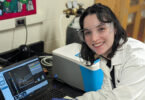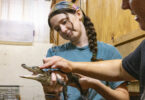That soreness you feel after a workout is a good thing—it’s an indicator of your body at work, fixing and rebuilding your muscles to make you stronger.
The process involves “satellite cells,” which are cells located in skeletal muscles that work to regenerate new muscle cells. They are considered to be the “stem cells of muscle,” said University of Georgia researcher Jarrod A. Call, and they are an important part of what keeps our muscles strong and healthy.
But as we age, or in some diseases that affect muscles, such as muscular dystrophy, the number of these satellite cells decreases. This poses a problem, says Call, because often the best regimen as we age or treat these diseases is through muscle regeneration.
“With skeletal muscle mass loss with aging, a lot of the prescription for aged individuals is resistance weight training,” says Call. “And that’s going to cause some type of muscle damage from which they will have to recover.”
Working with Hang Yin, an assistant professor in the biochemistry and molecular biology department, Call is examining the external and internal forces that turn satellite cells on and off. Call is an assistant professor in the UGA College of Education’s kinesiology department and a faculty member at UGA’s Regenerative Bioscience Center. His Muscle Physiology Lab assesses muscle strength recovery for Yin’s project.
The research is part of a larger grant awarded to Yin by the National Institutes of Health.
Satellite cells, Call says, have an active state and a non-active state. If your muscles haven’t gone through a workout, these cells remain in a quiescent state, as if they were sleeping. But when there is some sort of muscle injury through exercise, they become active and begin multiplying.
Understanding these two states is critical, Call says. By using a molecular compound called a HIF2a inhibitor, it allows researchers to trick satellite cells into turning on, potentially controlling the amount of these cells in muscle.
The next step in the study is to look at FDA-approved drugs that could modulate HIF2a. Call and the other researchers are also investigating satellite cells at the molecular level to determine what regulates HIF2a or how many times a cell could regenerate.







